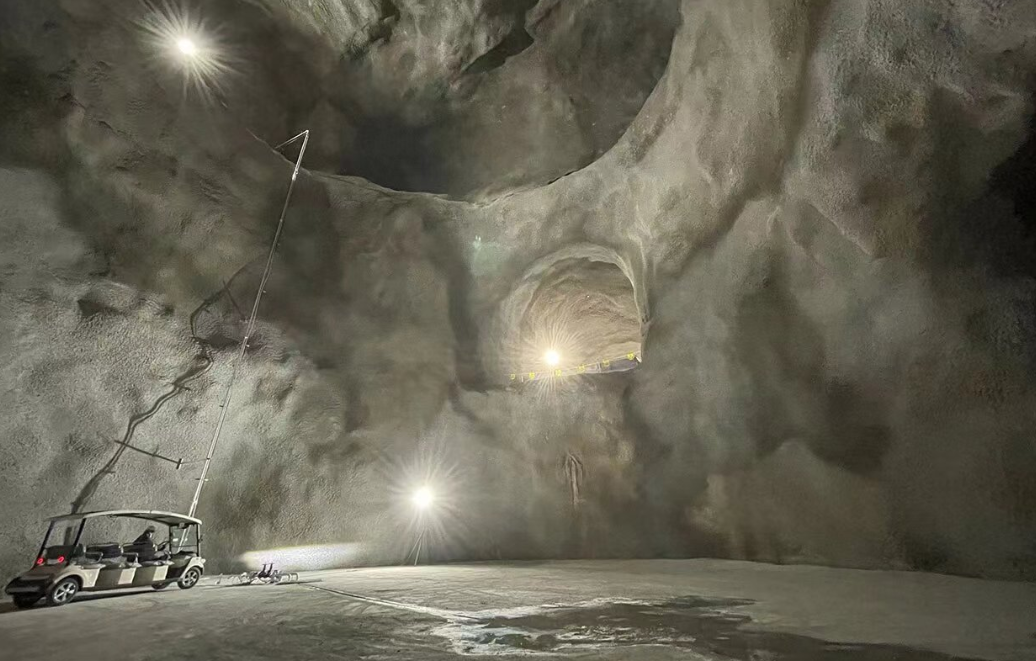
Dark matter has puzzled physicists for more than 20 years. The DAMA/LIBRA experiment at Italy's Gran Sasso National Laboratory (LNGS) has been recording annual fluctuations in flashes in its detectors that appear to be a sign of dark matter. But no one has been able to replicate these findings definitively.
But at Mount Jeongseon in South Korea, researchers are scaling up an experiment that could finally put the debate over dark matter to rest, Nature reports. In June, they will install improved detectors in a brand new facility called Yemilab.
Hyun Su Lee, a physicist at the Institute of Basic Science (IBS) in Daejeon, South Korea, said that if all goes according to plan, the upgraded COSINE-100 experiment will be operational by August.
Yemilab was built in an old mine 1,000 meters underground.
Dark matter is thought to make up 85 percent of the mass of the universe, but because it hardly interacts with ordinary matter, nor does it interact with light, it is difficult to observe directly. Several research groups have tried to get a glimpse of this elusive substance, but only the DAMA/LIBRA experiment claims to have actually seen it.
The prospect of confirming dark matter observations has caught the attention of physicists. "The dark matter community is working hard to replicate this result," said Nicola Rossi, an experimental particle physicist at LNGS.
The DAMA/LIBRA observations of different annual patterns are consistent with what physicists would expect of Earth's relative position in the galaxy throughout the year. As the earth orbits the Sun, the sun orbits the black hole at the center of our galaxy. In June, Earth passed through the Milky Way in the same direction as the sun, increasing its relative speed through dark matter.
But in December, as dark matter flows, the Earth moves in the opposite direction from the sun. As expected, the number of signals recorded by the DAMA/LIBRA detector was highest in June and lowest in December.
Several research groups have attempted to reproduce the DAMA/LIBRA results in detectors using similar methods and materials, including using the same type of sodium iodide crystals that emit tiny flashes when struck by subatomic particles.
These include COSINE-100, which has been operating since 2016 at Yemilab's predecessor, the Xiangyang Underground Laboratory (Y2L) in South Korea. But it did not produce a result that matched the original experiment, raising questions about whether the year-to-year fluctuations in the signal were due to other causes, such as the detector itself or faulty analysis methods. "It's a puzzle that's still around 20 years later."
Luisa Sarsa, a physicist working on the ANAIS-112 experiment at the Canfranc underground laboratory in Spain. The experiment also focuses on replicating the DAMA/LIBRA results.
Henry Tsz-King Wong, a physicist from Taiwan, China, said that in order to confirm or rule out the DAMA/LIBRA claim forever, the experiment needs to match the original experiment as closely as possible. Although the COSINE-100 detector uses the same type of sodium iodide crystals, they emit three times more radiation than the crystals used in DAMA/LIBRA, which can obscure the weak signal of potential dark matter particles and make it difficult to produce definitive results.
Lee said the upgraded experiment used the same crystals used in the earlier COSINE-100 experiment, but added some enhancements to improve sensitivity. The team is also developing a set of sodium iodide crystals for the next phase of the COSINE-200 experiment, with a higher radioactive purity than DAMA/LIBRA's.
As co-leader of COSINE-100, Lee said that because of the lower radioactivity levels, the hope is to produce enough data in a shorter period of time to draw more reliable conclusions about the DAMA/LIBRA results and search for low-mass dark matter.
COSINE-100 will be housed in the brand new 3,000-square-meter Yemilab. The 31 billion won ($23 million) facility is located about 1 kilometer underground and exceeds Y2L in depth and volume. Since September 2023, the researchers have moved all Y2L experiments to Yemilab and will begin the next phase of work there at the end of this year.
Yemilab also offers a better shielding environment for detecting elusive particles other than dark matter.
The facility will also look for neutrinos - uncharged particles that have little to no mass. The second phase of the experiment, called AMoRE, will look for signs that two neutrons have decayed into protons and electrons without releasing neutrinos. This hypothetical process is called neutrino-free double beta decay, and if observed, it would prove that neutrinos are their own antiparticles.
Yeong-duk Kim, a physicist at IBS and a spokesman for AMoRE, said the upgraded neutrino detector will use about 160 kilograms of crystals embedded with molybdenum-100, a naturally occurring radioactive isotope. When AMoRE-II starts running later this year, it will be 100 times more sensitive than previous experimental versions.
Whether these two experiments are successful or not, Rossi says, will raise more questions. "If these two approaches fail, we should seriously start rethinking the universe."

